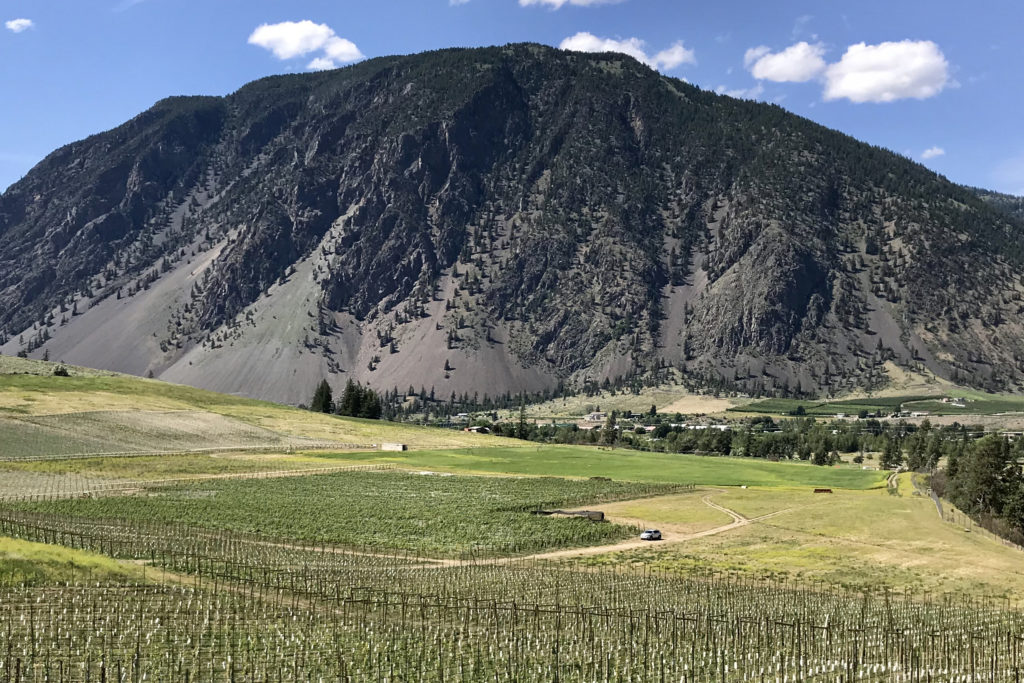Monte Creek Winery sits at the frontier of cool climate viticulture.
Our ultimate focus is to produce premium wines that are representative of our unique terroir.
- Lion’s Head Vineyard
- Monte Creek Vineyard
- Keremeos Vineyard
Lion’s Head Vineyard
The Lion’s Head Vineyard is a 300-acre property with twenty acres currently planted to grapes. Predominant varieties are Riesling, Frontenac Gris, Frontenac Blanc, Chardonnay and Marquette on this Southwest facing slope. Lion’s Head bluff rears above the vineyard and reflects heat back onto the property.
Monte Creek Vineyard
Monte Creek vineyard is a 900-acre property, with 300 acres of valley land. Fifty-five acres are currently planted to grapes, with more space dedicated to our greenhouse.
Due to the relatively flat aspect of the Monte Creek vineyard, the difference in daylight hours between it and Lion’s Head is minimal, though you will notice the presence of windmills here to aid in air movement for frost protection. This vineyard is planted in a range of varieties such as Marquette, Foch, Pinot Noir, Riesling, Chardonnay and La Crescent.
Keremeos Vineyard
The vineyard near Keremeos is 110-acres that has forty acres planted with Chardonnay, Riesling, Cabernet Franc and Pinot Noir. Planting began in 2018, and our young vines have started to produce high-quality fruit.
This vineyard is also a part of our cover crop program where we are exploring utilizing plants native to the valleys of the Southern Interior of British Columbia. Cover crops are what winegrowers plant between the rows of grapes in vineyards in order to enhance grape quality and the vineyard environment. Many wineries have moved beyond the old-school image of bare dirt between their vineyard rows, but some wineries, like Monte Creek, are taking it a step further by utilizing native plants and by constructing specific blends for our soil type and vineyard quality targets.

Our South Thompson Climate
The South Thompson valley is a semi-arid climate, with hot, dry days and cool nights. Our growing season extends from bud break, which is generally at the beginning of May, to harvest, which begins in September and extends into October.
Thanks to the lack of humidity and the natural resistance of our unique varieties, our vineyards have a low susceptibility to disease, resulting in healthy and flavourful fruit. This also allows us to have a very limited spray program, which is particularly important as the vineyards transition towards organic status. We hope to apply for this in 2023.
Silty Soil
The silty and uniform soil found in our vineyards is the result of the last ice age. A glacier crept down the North Thompson Valley and blocked the South Thompson River, creating a huge glacial lake in the South Thompson valley. As the glacier eroded the rock beneath it, glacial silt was gradually deposited in the lakebed. Eventually, the glacial ice dam burst, draining the lake. The result is the deep, silty soil found in our vineyards.
The tops of the cliffs visible on both sides of the South Thompson valley represent the floor of the ancient lake. The river has since carved through the silt to give the valley the geography you see today. These soils are free-draining and do not have a large amount of water holding capacity. As such, our vineyards must be irrigated – though grapevines require very little water, and are more sustainable in a dry region than most other crops, our climate would still prove to be far too dry even for them.
Farming for Flavour
Within the vineyards, we are farming for flavour. Every decision made in the vineyard reflects this maxim, whether it is pruning, shoot thinning, leaf removal, cluster thinning, harvesting, or any of the other myriad tasks that take place throughout the year.
Grapes are harvested at their peak of flavour, though oftentimes the flavour profile of the fruit will change throughout the ripening process. Judging the profile and the depth of flavour is the job of the winemaker, who ultimately determines picking decisions.
Our Viticulture and Winemaking Philosophy
Our team is obsessed with sustainability.
We are humbled by the historical geological events that formed the land and the prized soils that provide the terroir that is so unique to our place. All the farming that we do honours the soils, as we work to keep the land free from chemical inputs so that the resulting grapes and the eventual wines we drink are better for both the earth and our bodies.
We celebrate the idea that great wines only come from balanced vines and earth that is truly alive and thriving. To grow incredible fruit, we must promote and maintain an environment that is healthy and working with nature, not against it.
Our winemaking philosophy is to showcase our terroir. We have vineyards in an extraordinary place, and we want to showcase what makes our site unique by letting the wines speak for themselves. What this means is that the winemaking is intended to be a guiding tool in letting the fruit express itself, rather than a more heavy-handed approach that might hide the terroir. Thus, we produce high-quality wines with minimal intervention. Our goal as winemakers is to focus on caretaking the land first, and in doing so, the health of our vines and the quality of our wine will come naturally.



